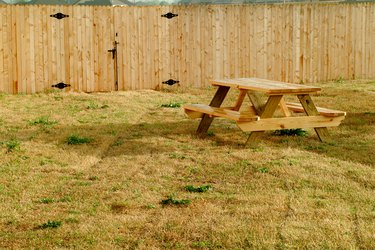
Lawn care and maintenance can take time, but they are invaluable to keeping your grass healthy. Know the composition of your soil and what pH it carries. Soil pH, or the acidity of the soil, is important to the health of grass and can affect nutrient uptake in plants or indicate a mineral deficiency in the earth.
If soil is acidic, you can amend it. Adding lime will "sweeten" soil. Lime is just crushed quarry limestone that comes in different types, and it is easy to apply. It typically lasts for a couple of years and will increase the calcium and magnesium in the soil.
Video of the Day
Video of the Day
Soil Tests Indicate Acidity
Determining if the lawn is in acidic soil requires you to know what kind of sod you are growing and the pH of your soil. Kentucky bluegrass prefers a soil pH of 6.5 to 7.2, whereas fescues like soil to be more acidic, in the range of 6.0 to 6.5. Acidic soil will be in the range of 6, which is fine for the fescue but likely to cause nutrition issues in other turf varieties.
A good base soil pH that groundskeepers strive for is between 6.0 and 7.0. This is in the middle range of acidic and alkaline. A soil test will give you excellent evidence of whether your lawn is acidic. You can purchase a kit or take a soil sample to a university extension service.
Mosses Indicate Acidity
Assessing the portion of your lawn that is moss will give you an indication if your lawn is acidic. Lots of moss means high acidity. Mosses like acidic soil and will be encouraged to grow in your lawn if this condition exists. Shepherd's purse is a similar kind of weed indicator because it is capable of growing in very acidic soil.
Acidic soil increases the presence of weeds, thatch, and toxic materials built up in soil. The presence of mullein and pearly everlasting are other indicators that your grass is living in acidic soil.
Other Cues and Clues
A lawn in acidic soil may become yellowed and limp. The lawn may also thin out and have bare patches. Also, highly acidic soil reduces the effectiveness of fertilizer, so if you have been faithful with application but your lawn still looks unhealthy, it is time to have a soil test.
Another way to determine if your lawn is acidic is to look at your region. Areas with lots of rainfall, such as the Pacific Northwest, tend to be acidic due to leaching of calcium. Arid zones will have a more alkaline base. A soil test remains the best way to determine your lawn's acidity.